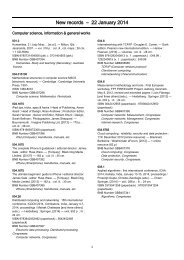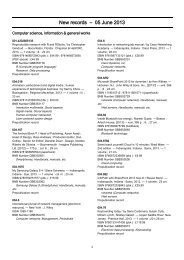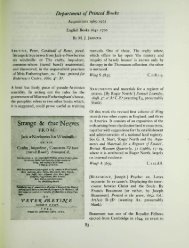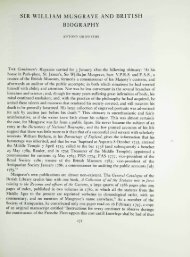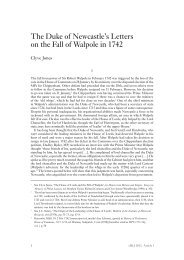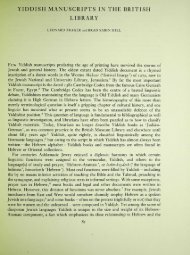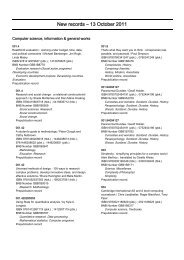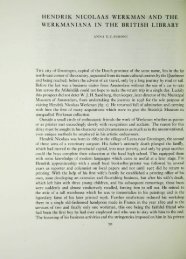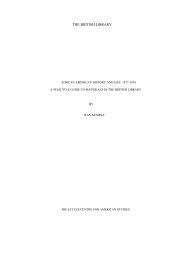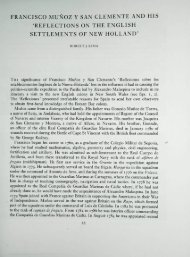A Medieval Psalter 'Perfected': Eighteenth-Century ... - British Library
A Medieval Psalter 'Perfected': Eighteenth-Century ... - British Library
A Medieval Psalter 'Perfected': Eighteenth-Century ... - British Library
You also want an ePaper? Increase the reach of your titles
YUMPU automatically turns print PDFs into web optimized ePapers that Google loves.
A <strong>Medieval</strong> <strong>Psalter</strong> ‘Perfected’: <strong>Eighteenth</strong>-<strong>Century</strong> Conservationism and an Early (Female) Restorer<br />
of Rare Books and Manuscripts<br />
even in the inchoate notions of the time as to what that constituted. Facing this image, on<br />
the recto, is a title page that contains the Hebrew words for Book of Psalms, followed by a<br />
description of the book’s contents in Latin (fig. 16). The script does emulate the Gothic hand<br />
used throughout the manuscript, but the title page is still an invention from the advent of<br />
print, effectively unheard-of in medieval manuscripts. 32<br />
The second frontispiece miniature similarly disregards the medieval style of the historiated<br />
initials in preference for a more contemporary mode (fig. 17). Here, Christ and two disciples<br />
amble in conversation along a road traversing a soft landscape. Loose and impressionistic<br />
brushwork creates puffy clouds that curtain the upper right corner of the image, a lush tree<br />
that caps the scene at the left edge, and a path that swerves off gently into the foreground – all<br />
techniques and compositional elements characteristic of academic painting in the eighteenth<br />
century, straight out of the scenes by Richard Wilson and Paul Sandby. Yet, given how closely<br />
Denyer hewed to the medieval aspect of decorative elements, it seems plausible that, in these<br />
instances, she opted out of authenticity or possibly even judged her skills unequal to the<br />
purposeful archaism that a large scene would require. Taken together, Denyer’s campaign<br />
was neither dogmatic in projecting the original look of the manuscript back on to its new<br />
leaves, nor insouciant to its historical character.<br />
What elevates the project above beautification is the series of notes at the front of the volume,<br />
which serves as an internal dossier on the manuscript’s restoration. On the first folio, each<br />
miniature initial is described, and the choice of iconography explained. For example, ‘In the<br />
Capital of the 52 Psalm, A Reveling according to the 3 & 4 verses. God looked down from<br />
Heaven upon the Children of Men; But they are all gone out of the way’. 33 On the following<br />
folio is the note quoted in full above, recounting how the manuscript came into the hands of<br />
Eliza Denyer. The note was written by Denyer’s father John, and beneath it is his own signature,<br />
as well as a cameo depiction of him in silhouette, made on a separate slip of thick paper and<br />
mounted on to the present page. Beneath his signature and cameo is a memo, apparently in<br />
Eliza Denyer’s hand, which explains the older numeration of the Psalms. Finally, on the last<br />
folio of preliminaries is a tally of all the illuminations in the <strong>Psalter</strong>. 34 This note was written by<br />
Eliza’s mother, who appears, as her father did before, in a cameo depiction in silhouette, with<br />
her signature beneath. Although not its intention, Martha Denyer’s autograph note does give a<br />
terminus ante quem of 1796 for the entire project, since Martha died in that year. 35<br />
Despite the absence of technical information in these notes, they still have a testamentary<br />
value that appears to have been their point. Through a series of both textual and visual<br />
commemorations, they document key details of the restoration and its participants, presumably<br />
(although perhaps only subconsciously) for the benefit of later generations. Denyer voices<br />
in her will a similar awareness of the need for diligence in combating oblivion, in a passage<br />
that worries over the degradation of her parents’ memory. As an ‘indispensable condition’<br />
of her bequest to Christ’s Hospital, Denyer insisted that its governors care in perpetuity for<br />
the memorial tablet honouring her mother and father in Chelsea Old Church. The condition<br />
is laid out at length with an arguably excessive number of provisos. 36 In fact, Denyer’s<br />
32<br />
Admittedly, it is unlikely that Denyer would have been aware of this, especially given that she appears to have<br />
had far greater exposure to early printed books than manuscripts. Margaret M. Smith, The Title-Page: Its<br />
Early Development 1460-1510 (London, 2000).<br />
33<br />
Add. MS. 6894, f. 1.<br />
34<br />
‘Paintings illuminations and Borders in this MS / Paintings with Borders before the Frontispiece and the first<br />
Psalm / 6 illuminated Lettirs [sic] / Ps. 1, 26, 38, 52, 87, 109 / 2 Blooming Letters / Ps. 68, 80 / 9 Borders /<br />
2 Tail Pieces / 193 Leaves’ (Add. MS. 6894, f. 3).<br />
35<br />
A similar cameo, in which her parents appear together, was mounted in another manuscript with paintings by<br />
Eliza (Add. MS. 6895, f. 54).<br />
36<br />
For example: ‘in case the said parish church shall be pulled down, then to remove the said tablet or place a new<br />
one to be kept in repair in like manner with the same inscription in the new church of the parish of Chelsea<br />
aforesaid’ (TNA, Prob, 11/1685; punctuation added).<br />
22<br />
eBLJ 2013, Article 3



